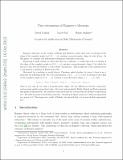Two extensions of Ramsey’s theorem
Author(s)
Conlon, David; Fox, Jacob; Sudakov, Benny
DownloadFox_Two extensions.pdf (247.9Kb)
OPEN_ACCESS_POLICY
Open Access Policy
Creative Commons Attribution-Noncommercial-Share Alike
Terms of use
Metadata
Show full item recordAbstract
Ramsey’s theorem, in the version of Erdos and Szekeres, states that every 2-coloring of the edges of the complete graph on {1,2,…,n} contains a monochromatic clique of order (1/2)logn. In this article, we consider two well-studied extensions of Ramsey’s theorem. Improving a result of Rodl, we show that there is a constant c > 0 such that every 2-coloring of the edges of the complete graph on {2,3,…,n} contains a monochromatic clique S for which the sum of 1/logi over all vertices i ∈ S is at least clogloglogn. This is tight up to the constant factor c and answers a question of Erdos from 1981. Motivated by a problem in model theory, Vaananen asked whether for every k there is an n such that the following holds: for every permutation π of 1,…,k − 1, every 2-coloring of the edges of the complete graph on {1,2,…,n} contains a monochromatic clique a[subscript 1]<⋯<a[subscript k] with
a[subscript π(1)+1] − a[subscript π(1)] > a[subscript π(2)+1] − a[subscript π(2) >⋯> a[subscript π(k−1)+1] − a[subscript π(k−1)].
That is, not only do we want a monochromatic clique, but the differences between consecutive vertices must satisfy a prescribed order. Alon and, independently, Erdős, Hajnal, and Pach answered this question affirmatively. Alon further conjectured that the true growth rate should be exponential in k. We make progress towards this conjecture, obtaining an upper bound on n which is exponential in a power of k. This improves a result of Shelah, who showed that n is at most double-exponential in k.
Date issued
2013-12Department
Massachusetts Institute of Technology. Department of MathematicsJournal
Duke Mathematical Journal
Publisher
Duke University Press
Citation
Conlon, David, Jacob Fox, and Benny Sudakov. “Two Extensions of Ramsey’s Theorem.” Duke Mathematical Journal 162, no. 15 (December 2013): 2903–2927.
Version: Author's final manuscript
ISSN
0012-7094